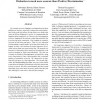HASE
2008
IEEE
14 years 7 months ago
2008
IEEE
This paper proposes a lightweight checkpointing scheme for real-time embedded systems. The goal is to separate concerns by allowing applications to take checkpoints independently ...
HASE
2008
IEEE
14 years 7 months ago
2008
IEEE
Due to the large number of attacks on open networks, information theft becomes a more and more severe problem. Secure computation can offer highly assured confidentiality protecti...
HASE
2008
IEEE
14 years 7 months ago
2008
IEEE
For complex services, logging is an integral part of many middleware aspects, especially, transactions and monitoring. In the event of a failure, the log allows us to deduce the c...
HASE
2008
IEEE
14 years 7 months ago
2008
IEEE
With the increasing complexity in software and electronics in safety-critical systems new challenges to lower the costs and decrease time-to-market, while preserving high assuranc...
HASE
2008
IEEE
14 years 7 months ago
2008
IEEE
Privacy, preservation and performance (“3 P’s”) are central design objectives for distributed data management systems. However, these objectives tend to compete with one ano...
HASE
2008
IEEE
14 years 7 months ago
2008
IEEE
— UML 1 sequence diagrams have been widely employed for modeling software requirements and design. UML 2 introduced many new features, such as Combined Fragments, to make sequenc...
HASE
2008
IEEE
14 years 7 months ago
2008
IEEE
—Formal methods provide remarkable tools allowing for high levels of confidence in the correctness of developments. Their use is therefore encouraged, when not required, for the...
HASE
2008
IEEE
14 years 7 months ago
2008
IEEE
A high assurance system requires both functional and nonfunctional correctness before the system is put into operation. To examine whether a system’s actual performance complies...
HASE
2008
IEEE
14 years 7 months ago
2008
IEEE
HASE
2008
IEEE
14 years 7 months ago
2008
IEEE
Model-based program debugging exploits discrepancies between the program behavior anticipated by a programmer and the program’s actual behavior when executed on a set of inputs....



